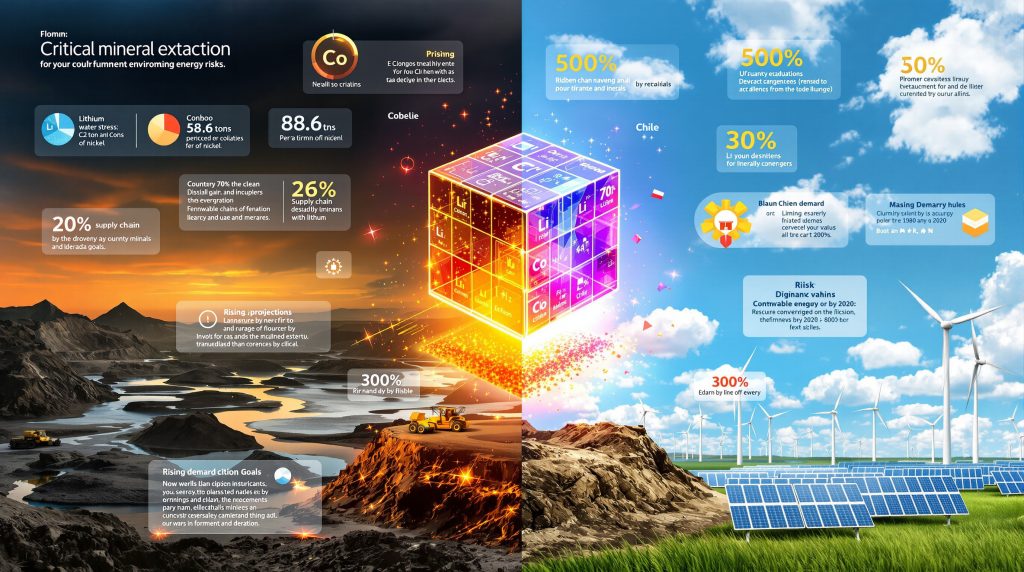The risks of extracting critical minerals pose unprecedented environmental challenges that extend far beyond traditional mining concerns. As global demand for materials essential to renewable energy technologies surges, the environmental costs of securing these resources have become increasingly severe. Mining operations for lithium, cobalt, nickel, and rare earth elements consume vast quantities of freshwater while generating contaminated waste streams that persist for decades. The irony is stark: the materials needed to combat climate change often cause significant environmental damage during extraction.
Water depletion represents one of the most pressing concerns in critical mineral extraction. Lithium brine extraction in Chile's Atacama Desert requires approximately 500,000 gallons of water to produce one ton of lithium carbonate. This intensive water use occurs in regions already experiencing severe water stress, forcing local communities to compete with mining operations for this essential resource. Indigenous communities in these areas report wells running dry and traditional agricultural practices becoming unsustainable.
The contamination footprint extends beyond immediate mining areas through acid mine drainage and heavy metal leaching. Copper and nickel mining operations generate sulfide-rich waste rock that produces acidic runoff for generations. This contamination spreads through groundwater systems and surface water bodies, affecting ecosystems hundreds of kilometers from extraction sites.
Ecosystem Disruption and Biodiversity Loss
Mining operations fundamentally alter natural landscapes through habitat destruction and chemical contamination. Open-pit mines for copper and lithium extraction remove entire mountain tops and create massive waste disposal areas that eliminate existing ecosystems. These disruptions fragment wildlife corridors essential for species migration and breeding, particularly affecting endemic species adapted to specific geological conditions.
The scale of ecosystem disruption varies significantly by extraction method:
- Open-pit mining: Complete habitat removal across hundreds of hectares
- Underground mining: Subsidence and groundwater disruption affecting surface ecosystems
- Brine extraction: Alteration of salt flat ecosystems and water table depletion
- Placer mining: River channel modification and sediment contamination
Recovery of these ecosystems faces significant challenges due to soil contamination and altered hydrology. Studies of abandoned mining sites show that natural recovery processes can take centuries, while active remediation efforts achieve limited success in restoring original biodiversity levels. Furthermore, mine reclamation innovations are being developed to address these long-term environmental impacts.
Carbon Footprint Paradox
The carbon emissions associated with critical mineral extraction create a troubling paradox for climate action. Processing facilities for nickel, cobalt, and rare earth elements require intensive energy inputs, often supplied by coal-powered electricity grids in major producing countries. This energy intensity means that materials intended to reduce global carbon emissions actually generate substantial emissions during production.
Nickel processing in Indonesia exemplifies this challenge, with facilities powered primarily by coal-fired power plants. The carbon intensity of Indonesian nickel production significantly exceeds global averages due to both processing requirements and energy source selection. Similar patterns occur across other critical mineral supply chains, particularly in China, where coal remains the dominant energy source for industrial processes. However, mining decarbonisation benefits are increasingly recognised as companies transition to renewable energy sources.
Climate Vulnerabilities Affecting Mining Infrastructure
Mining operations face escalating risks from climate change impacts that threaten both operational continuity and worker safety. These vulnerabilities create cascading effects throughout global supply chains as extreme weather events become more frequent and severe. The International Energy Agency projects that demand for critical minerals may triple by 2030 and quadruple by 2040, intensifying pressure on mining infrastructure already struggling with climate adaptation.
Extreme weather events have caused significant operational disruptions across major mining regions. Cyclones and flooding in Australian mining areas have forced temporary shutdowns of iron ore and lithium operations, while extended drought conditions affect water-dependent processing facilities. These disruptions create supply shortages that ripple through global manufacturing networks, demonstrating the fragility of concentrated supply chains.
Infrastructure Resilience Challenges
Mining infrastructure typically operates with minimal redundancy, making operations vulnerable to single-point failures during extreme weather events. Transportation networks connecting remote mining sites to processing facilities and ports represent particularly vulnerable links in the supply chain. Rail lines, access roads, and port facilities face increasing risks from sea level rise, flooding, and extreme temperature fluctuations.
Power generation systems supporting energy-intensive mining operations require reliable electricity supply that becomes compromised during extreme weather. Many mining regions depend on aging electrical grid infrastructure that struggles to maintain service during heat waves, storms, and other climate-related disruptions. This vulnerability forces mining companies to invest in backup power generation systems that often rely on diesel fuel, increasing operational costs and carbon emissions.
Water supply infrastructure faces dual pressures from increasing demand and decreasing availability due to changing precipitation patterns. Mining operations require consistent water access for mineral processing, dust suppression, and equipment cooling, but climate change alters regional hydrology in ways that threaten long-term water security. Drought conditions can force temporary production reductions or complete shutdowns when water reserves become inadequate.
Regional Climate Risk Assessment
Different mining regions face distinct climate vulnerabilities that affect operational planning and risk management strategies:
- Australia: Increasing cyclone intensity and extended drought periods
- Chile: Accelerating glacial retreat affecting water supplies
- Indonesia: Rising sea levels threatening coastal processing facilities
- Democratic Republic of Congo: Changing rainfall patterns affecting transportation access
- China: Extreme temperature fluctuations affecting equipment performance
These regional variations require location-specific adaptation strategies that consider local climate projections and infrastructure vulnerabilities.
Occupational Health Hazards in Critical Mineral Mining
Workers in critical mineral extraction face severe health risks that often exceed those found in conventional mining operations. The unique chemical properties of materials like lithium, cobalt, and rare earth elements create novel exposure pathways that existing safety protocols may inadequately address. As mining operations expand into more challenging environments and employ innovative extraction methods, worker health risks continue to evolve.
Respiratory health hazards represent the most immediate concern for mining workers. Crystalline silica exposure occurs across all mining operations, causing progressive lung scarring that leads to silicosis and increased lung cancer risk. Critical mineral mining compounds these risks through exposure to specific metal dusts and processing chemicals that can cause acute and chronic respiratory diseases.
Chemical Exposure Risks
Critical mineral processing involves handling highly toxic substances that require specialised safety measures:
| Chemical Exposure | Health Effects | Primary Sources | Long-term Risks |
|---|---|---|---|
| Heavy metals (arsenic, cadmium) | Organ damage, cancer | Ore processing, smelting | Kidney failure, neurological disorders |
| Processing acids | Chemical burns, respiratory damage | Leaching operations | Chronic respiratory disease |
| Lithium compounds | Kidney dysfunction, thyroid disruption | Brine processing | Reproductive health effects |
| Rare earth dusts | Lung inflammation, fibrosis | Mining, crushing operations | Progressive lung disease |
Heat stress presents an escalating concern as mining operations expand into tropical and desert regions. Underground workers face extreme temperatures that can exceed safe working limits, while surface operations in areas like Chile's Atacama Desert subject workers to dangerous heat exposure. Climate change exacerbates these conditions by increasing ambient temperatures and extending periods of extreme heat.
Emerging Health Concerns from New Technologies
Re-mining operations that extract valuable materials from previously discarded waste create novel health risks. These processes expose workers to concentrated heavy metals and toxic compounds that accumulated over decades in tailings piles and waste rock. The heterogeneous composition of these materials makes exposure assessment challenging and may overwhelm existing safety protocols designed for primary extraction operations.
Automated mining technologies introduce new categories of occupational hazards while potentially reducing others. Remote-controlled equipment and autonomous vehicles can reduce direct worker exposure to hazardous materials but create risks related to equipment malfunction and maintenance requirements in contaminated environments.
Mental health impacts in mining communities extend beyond direct occupational hazards. Social disruption, environmental degradation, and economic uncertainty associated with mining operations contribute to elevated rates of depression, anxiety, and substance use disorders among workers and community members.
Human Rights Violations in Critical Mineral Supply Chains
Critical mineral extraction occurs predominantly in regions with weak regulatory oversight, creating conditions where human rights violations flourish. The concentration of production in developing nations with limited enforcement capacity enables practices that would be prohibited in countries with stronger labour protections. As Anabella Rosemberg of Climate Action Network International emphasises, the transition must work for people who live beside mines, workers carrying risks, Indigenous peoples defending homelands, and communities in the Global South who deserve dignity and economic justice, not just promises on paper.
Forced labour represents one of the most severe violations occurring in critical mineral extraction. Workers face dangerous conditions with inadequate safety equipment whilst receiving wages insufficient for basic subsistence. The remote location of many mining operations and limited government oversight enable coercive labour practices that trap workers in exploitative arrangements.
Indigenous Rights and Land Displacement
Critical mineral deposits frequently overlap with Indigenous territories, creating conflicts over land use and resource rights. Mining companies often proceed with extraction projects without obtaining free, prior, and informed consent from affected Indigenous communities. This violation of internationally recognised Indigenous rights results in forced displacement, loss of traditional livelihoods, and destruction of sacred sites.
The scale of Indigenous territory overlap varies by region and mineral type:
- Lithium extraction: Significant overlap in South American salt flats
- Cobalt mining: Displacement of traditional communities in Central Africa
- Rare earth extraction: Impacts on Indigenous lands in China and Myanmar
- Copper mining: Territory conflicts across multiple continents
Community benefit-sharing arrangements often prove inadequate or nonexistent, leaving Indigenous communities bearing environmental and social costs whilst receiving minimal compensation or development benefits.
Labour Rights Abuses and Working Conditions
Systematic labour rights violations occur across critical mineral supply chains, particularly in artisanal and small-scale mining operations that supply materials to larger commercial enterprises. These violations include:
Critical Insight: Child labour in cobalt mining affects thousands of children who work in dangerous conditions without protective equipment, often carrying heavy loads and working in unstable pits that can collapse without warning.
Working conditions in industrial mining operations frequently violate international safety standards. Workers face exposure to toxic chemicals without adequate protective equipment, work excessive hours without proper rest periods, and lack access to healthcare for occupational injuries and illnesses.
Gender-based violence and exploitation represent systematic problems in mining regions. The influx of predominantly male workers into remote areas creates conditions where sexual assault and exploitation of local women increase significantly. These crimes often go unreported due to limited legal recourse and power imbalances between mining companies and local communities.
Supply Chain Vulnerabilities and Risk Concentration
Critical mineral supply chains exhibit dangerous concentration patterns that amplify the risks of extracting critical minerals and create systemic vulnerabilities across global markets. Geographic concentration of production in specific regions means that political instability, natural disasters, or regulatory changes in a small number of countries can disrupt global supply chains for essential clean energy materials.
The Democratic Republic of Congo's dominance in cobalt production illustrates these concentration risks. Supplying approximately 70% of global cobalt, the DRC's political instability and weak governance create supply security concerns for electric vehicle manufacturers and battery producers worldwide. Similar concentration patterns exist for other critical minerals, with China controlling significant portions of rare earth element processing and Australia dominating lithium production.
Geopolitical Supply Disruptions
Trade tensions and geopolitical conflicts can rapidly disrupt critical mineral supply chains, forcing companies to source materials from alternative suppliers that may have lower environmental or labour standards. The ongoing US-China trade relationship affects rare earth element availability, whilst regional conflicts can disrupt mining operations and transportation networks.
Resource nationalism policies in producing countries create additional supply vulnerabilities. Governments may restrict mineral exports to support domestic processing industries or respond to international pressure, forcing global supply chains to adapt rapidly to new sourcing constraints. Moreover, critical minerals energy security has become a strategic priority for many nations.
Transportation and Processing Bottlenecks
Limited transportation infrastructure connecting remote mining operations to global markets creates supply chain chokepoints vulnerable to disruption. Many critical mineral deposits are located in regions with minimal road, rail, or port infrastructure, making operations dependent on specific transportation routes that can be compromised by extreme weather or political instability.
Processing capacity concentration represents another critical vulnerability. China's dominance in rare earth element refining means that raw materials from multiple countries must pass through Chinese facilities before reaching end users. This processing bottleneck creates dependencies that force materials through specific facilities regardless of their environmental or labour standards.
Regulatory Responses and Policy Development
International recognition of the risks of extracting critical minerals is driving new regulatory frameworks and policy initiatives designed to address environmental and social impacts across supply chains. For the first time, UN climate negotiations include specific language addressing critical mineral extraction risks, recognising the need to balance clean energy transitions with environmental protection and human rights.
The draft language being considered by climate negotiators acknowledges social and environmental risks associated with scaling up supply chains for clean energy technologies, including risks arising from extraction and processing of critical minerals. This represents a significant shift toward recognising that the materials needed for climate solutions can create their own environmental and social challenges.
International Framework Development
Recent UN reports recommend several key policy interventions to address extraction risks:
- Supply chain transparency: Requirements for companies to trace mineral sources and document environmental and social impacts
- Legacy funding mechanisms: Financial reserves for abandoned mine remediation and long-term environmental restoration
- Recycling enhancement: Investment in circular economy approaches to reduce primary extraction demand
- Indigenous rights protection: Implementation of free, prior, and informed consent protocols
These recommendations reflect growing international consensus that critical mineral extraction must meet higher environmental and social standards than historical mining practices.
National Policy Initiatives
Individual countries are developing critical mineral strategies that attempt to balance supply security with responsible sourcing requirements. The United States and Australia have reached agreements to jointly invest in mines and mineral processing projects, whilst the Group of Seven launched initiatives to bolster critical mineral allocations with planned investments exceeding $1 billion.
European Union due diligence requirements for mineral importers represent one of the most comprehensive regulatory approaches to addressing supply chain risks. These regulations require companies to demonstrate compliance with environmental and human rights standards throughout their mineral supply chains, creating incentives for improved practices at extraction sites.
Corporate Accountability Measures
Emerging regulations require mining companies and mineral users to implement comprehensive due diligence systems that track materials from extraction through final product manufacturing. These requirements include:
- Third-party auditing of mining operations and processing facilities
- Real-time monitoring of environmental impacts and worker safety conditions
- Community grievance mechanisms that provide recourse for affected populations
- Public reporting of supply chain risks and mitigation efforts
Companies face increasing pressure from investors and consumers to demonstrate responsible sourcing practices, creating market incentives for improved environmental and social performance across critical mineral supply chains.
Risk Mitigation Strategies and Industry Innovation
Addressing the risks of extracting critical minerals requires comprehensive strategies that integrate technological innovation, regulatory compliance, and community engagement across entire supply chains. Mining companies and mineral users are developing new approaches to reduce environmental impacts whilst maintaining the supply security necessary for clean energy transitions.
Sustainable mining technologies offer potential solutions to some environmental challenges associated with critical mineral extraction. Water recycling systems can reduce freshwater consumption in mineral processing, whilst renewable energy installations at mining sites can decrease carbon emissions from extraction operations. However, implementing these technologies requires significant capital investment and may face technical challenges in remote mining locations.
Technological Innovation in Extraction Methods
Advanced extraction technologies show promise for reducing environmental impacts whilst maintaining production efficiency:
- In-situ recovery methods: Minimise surface disruption by extracting minerals underground without traditional mining
- Selective extraction processes: Reduce waste generation by targeting specific minerals with higher precision
- Closed-loop water systems: Eliminate wastewater discharge through complete recycling of process water
- Automated safety systems: Reduce worker exposure to hazardous conditions through remote operation
These innovations require substantial research and development investment but offer pathways to reduce the most severe risks associated with critical mineral extraction. Furthermore, direct lithium extraction technologies are being developed to reduce water consumption and environmental impacts.
Community Engagement and Benefit Sharing
Mining companies are developing more comprehensive approaches to community engagement that go beyond traditional consultation processes. Meaningful benefit-sharing arrangements ensure that local communities receive tangible benefits from extraction activities occurring on or near their territories.
Effective community engagement strategies include:
- Revenue sharing agreements that provide long-term income to affected communities
- Local employment and training programmes that build capacity for sustainable economic development
- Infrastructure development investments that improve healthcare, education, and transportation access
- Environmental restoration commitments that address legacy contamination and prevent future damage
Success in community engagement requires long-term commitment and recognition that extraction operations must generate positive outcomes for all stakeholders, not just mineral companies and end users.
Supply Chain Transparency and Traceability
Developing comprehensive traceability systems allows companies and consumers to understand the environmental and social impacts associated with specific mineral sources. Blockchain technology and digital tracking systems enable real-time monitoring of supply chain conditions from extraction through final product delivery.
Transparency initiatives must address several key challenges:
- Artisanal mining integration: Ensuring that small-scale mining operations meet the same standards as industrial facilities
- Multi-jurisdictional compliance: Navigating different regulatory requirements across producing and consuming countries
- Data verification: Confirming accuracy of reported environmental and social performance metrics
- Cost allocation: Distributing the expenses of tracking and verification systems across supply chain participants
Future Outlook for Critical Mineral Extraction
The risks of extracting critical minerals will intensify as demand escalates to meet clean energy transition goals. Demand projections indicate that critical mineral requirements may triple by 2030 and quadruple by 2040, creating unprecedented pressure on extraction systems already struggling with environmental and social challenges. This scaling challenge will test the industry's ability to implement sustainable practices whilst meeting urgent supply requirements.
Technological advancement in extraction and processing methods offers potential solutions to current challenges, but implementation timelines may not align with rapidly increasing demand. Research into alternative materials and more efficient recycling processes could reduce primary extraction requirements, but these innovations require significant development periods and substantial investment.
Scaling Sustainable Practices
Successfully scaling critical mineral extraction whilst minimising environmental and social impacts requires coordinated action across multiple dimensions:
- Investment in sustainable technologies: Accelerating development and deployment of cleaner extraction methods
- Regulatory harmonisation: Establishing consistent environmental and social standards across producing regions
- Community empowerment: Ensuring affected populations have meaningful participation in extraction decisions
- Supply chain diversification: Reducing concentration risks by developing alternative sources and processing capacity
The transition period will likely involve continued exposure to extraction risks whilst mitigation strategies are developed and implemented. Melissa Marengo of the Natural Resource Governance Institute notes that extraction often creates impacts that are very expensive to remediate, if remediation is even possible, highlighting the importance of prevention over later intervention.
Integration with Climate Goals
Addressing critical mineral extraction risks requires integration with broader climate policy frameworks that recognise the interconnections between renewable energy deployment and resource extraction impacts. Climate negotiators are beginning to acknowledge these connections by including specific language about extraction risks in international agreements.
Future policy development must balance urgent climate action requirements with responsible resource extraction practices. This balance will require innovative approaches that accelerate clean energy deployment whilst ensuring that the materials needed for this transition are obtained through environmentally and socially sustainable means. Research from sustainable development studies emphasises the need for integrated approaches to mineral extraction and climate policy.
The success of global climate initiatives may ultimately depend on the industry's ability to transform critical mineral extraction from a source of environmental and social harm into a foundation for sustainable development that benefits all stakeholders in the clean energy transition.
Ready to Invest in the Next Major Mineral Discovery?
Discovery Alert instantly alerts investors to significant ASX mineral discoveries using its proprietary Discovery IQ model, turning complex mineral data into actionable insights. Understand why historic discoveries can generate substantial returns by visiting Discovery Alert's dedicated discoveries page, showcasing historic examples of exceptional outcomes, and begin your 30-day free trial today to position yourself ahead of the market.




